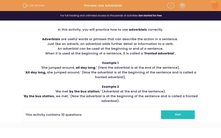In this activity, we will practise how to use adverbials correctly.
Adverbials are useful words or phrases that can describe the action in a sentence.
Just like an adverb, an adverbial adds further detail or information to a verb.
An adverbial can be used at the beginning or end of a sentence.
When it is used at the beginning of a sentence, it is called a 'fronted adverbial'.
Example 1
'She jumped around all day long.' (Here, the adverbial is at the end of the sentence - did you notice that there is no comma to separate the adverbial from the rest of the sentence?)
'All day long, she jumped around.' (Now the adverbial is at the beginning of the sentence and is called a fronted adverbial - we do need a comma to separate fronted adverbials from the rest of the sentence.)

Example 2
'We went to the park after the rain stopped.' (Adverbial at the end of the sentence).
'After the rain stopped, we went to the park.' (Now the adverbial is at the beginning of the sentence and is called a fronted adverbial. Did you spot the comma after it?)

Do you get the idea? Let's move on to some questions so that you can practise identifying adverbials.








